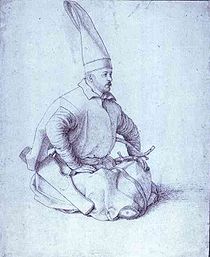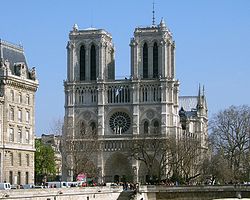
Ottoman embassy to France (1534)
Encyclopedia

Franco-Ottoman alliance
The Franco-Ottoman alliance, also Franco-Turkish alliance, was an alliance established in 1536 between the king of France Francis I and the Turkish ruler of the Ottoman Empire Suleiman the Magnificent. The alliance has been called "the first non-ideological diplomatic alliance of its kind between a...
for the next year, 1535. The embassy closely followed a first Ottoman embassy to France in 1533
Ottoman embassy to France (1533)
An Ottoman embassy to France was sent in 1533 by Hayreddin Barbarossa, the Ottoman Governor of Algiers, vassal of the Ottoman Emperor Suleiman the Magnificent....
, as well as the Conquest of Tunis
Conquest of Tunis (1534)
The conquest of Tunis occurred on 16 August 1534 when Hayreddin Barbarossa captured the city from the Hafsid ruler Muley Hasan.In 1533, Suleiman ordered Hayreddin Barbarossa, whom he had summoned from Algiers, to build a large war fleet in the arsenal of Constantinople...
by Hayreddin Barbarossa on 16 August 1534, which marked a strong reinforcement of Ottoman positions in the Western Mediterranean.
Arrival of the embassy
The Ottoman delegation arrived from ConstantinopleConstantinople
Constantinople was the capital of the Roman, Eastern Roman, Byzantine, Latin, and Ottoman Empires. Throughout most of the Middle Ages, Constantinople was Europe's largest and wealthiest city.-Names:...
via Tunis
Tunis
Tunis is the capital of both the Tunisian Republic and the Tunis Governorate. It is Tunisia's largest city, with a population of 728,453 as of 2004; the greater metropolitan area holds some 2,412,500 inhabitants....
at the French harbour of Marseille
Marseille
Marseille , known in antiquity as Massalia , is the second largest city in France, after Paris, with a population of 852,395 within its administrative limits on a land area of . The urban area of Marseille extends beyond the city limits with a population of over 1,420,000 on an area of...
in October 1534. The delegation included two French ambassadors to the Porte who had accompanied them from Constantinople: Antonio Rincon
Antonio Rincon
Antonio Rincon , also Antoine de Rincon, was a Spanish-born diplomat in the service of France An influential envoy from the King of France to Sultan Soleyman I of the Ottoman Empire, he made various missions to Istanbul between 1530 and 1541....
and Cantelmo.
The contemporary French writer and eyewitness Valbelle would comment:
The delegation was not composed of pirates, but of janissaries, clad in uniforms with immaculate turbans. They travelled overland with Antonio Rincon, and reached Francis I
Francis I of France
Francis I was King of France from 1515 until his death. During his reign, huge cultural changes took place in France and he has been called France's original Renaissance monarch...
at his court in Châtellerault
Châtellerault
Châtellerault is a commune in the Vienne department in the Poitou-Charentes region in France.It is located to the north of Poitou, and the residents are called Châtelleraudais.-Geography:...
.


Affair of the placards
The Affair of the Placards was an incident in which anti-Catholic posters appeared in public places in Paris and in four major provincial cities: Blois, Rouen, Tours and Orléans, overnight during 17 October 1534. One was actually posted on the bedchamber door of King Francis I at Amboise, an...
, in which Protestants issued pamphlets criticizing the Mass
Mass (liturgy)
"Mass" is one of the names by which the sacrament of the Eucharist is called in the Roman Catholic Church: others are "Eucharist", the "Lord's Supper", the "Breaking of Bread", the "Eucharistic assembly ", the "memorial of the Lord's Passion and Resurrection", the "Holy Sacrifice", the "Holy and...
in view of stopping efforts at a Catholic–Protestant rapprochement. Francis I was severely criticized for his tolerance towards Protestants, and had to pursue them. The Ottoman ambassadors accompanied Francis I to Paris, and attended the burning of those responsible for the Affair, on 21 January 1535 in front of the Cathedral of Notre-Dame de Paris.
Together a master plan was established for 1535, combining a revolt of pro-French factions in Italy; an Ottoman attack on Apulia
Apulia
Apulia is a region in Southern Italy bordering the Adriatic Sea in the east, the Ionian Sea to the southeast, and the Strait of Òtranto and Gulf of Taranto in the south. Its most southern portion, known as Salento peninsula, forms a high heel on the "boot" of Italy. The region comprises , and...
and Calabria
Calabria
Calabria , in antiquity known as Bruttium, is a region in southern Italy, south of Naples, located at the "toe" of the Italian Peninsula. The capital city of Calabria is Catanzaro....
; an attack by Barbarossa from Tunis
Tunis
Tunis is the capital of both the Tunisian Republic and the Tunis Governorate. It is Tunisia's largest city, with a population of 728,453 as of 2004; the greater metropolitan area holds some 2,412,500 inhabitants....
on Sicily
Sicily
Sicily is a region of Italy, and is the largest island in the Mediterranean Sea. Along with the surrounding minor islands, it constitutes an autonomous region of Italy, the Regione Autonoma Siciliana Sicily has a rich and unique culture, especially with regard to the arts, music, literature,...
, Naples
Naples
Naples is a city in Southern Italy, situated on the country's west coast by the Gulf of Naples. Lying between two notable volcanic regions, Mount Vesuvius and the Phlegraean Fields, it is the capital of the region of Campania and of the province of Naples...
and Tuscany
Tuscany
Tuscany is a region in Italy. It has an area of about 23,000 square kilometres and a population of about 3.75 million inhabitants. The regional capital is Florence ....
; and attacks by England, Scotland
Scotland
Scotland is a country that is part of the United Kingdom. Occupying the northern third of the island of Great Britain, it shares a border with England to the south and is bounded by the North Sea to the east, the Atlantic Ocean to the north and west, and the North Channel and Irish Sea to the...
and Denmark on the Low Countries
Low Countries
The Low Countries are the historical lands around the low-lying delta of the Rhine, Scheldt, and Meuse rivers, including the modern countries of Belgium, the Netherlands, Luxembourg and parts of northern France and western Germany....
, with the help of the German princes allied to France William of Fürstenberg and Christopher of Württemberg.
Departure and aftermath
The embassy departed Paris on 13 February 1535 with the new French ambassador to the Porte, Jehan de la Forest, accompanied by Charles de MarillacCharles de Marillac
Charles de Marillac was a French prelate and diplomat.-Career:De Marillac was, by the age of twenty-two, an advocate in parliament in Paris...
and the scholar Guillaume de Postel. Jehan de la Forest would successfully negotiate the Capitulations
Capitulations of the Ottoman Empire
Capitulations of the Ottoman Empire were contracts between the Ottoman Empire and European powers, particularly France. Turkish capitulations, or ahdnames, were generally bilateral acts whereby definite arrangements were entered into by each contracting party towards the other, not mere...
giving advantages and pre-eminence to France in relations with the Ottoman Empire. De la Forest also had secret instructions describing how he was to coordinate the military efforts between France and the Ottoman Empire:
The embassy arrived in Marseille on 3 April 1535 and departed on 11 April 1535 on the Ottoman galleys that had been waiting there. De la Forest departed together on a French galley, La Dauphine. They first stopped at Tunis, where Barbarossa armed a special galley to transport De la Forest to Constantinople.
Charles V
Charles V, Holy Roman Emperor
Charles V was ruler of the Holy Roman Empire from 1519 and, as Charles I, of the Spanish Empire from 1516 until his voluntary retirement and abdication in favor of his younger brother Ferdinand I and his son Philip II in 1556.As...
managed to wreck the plans of Francis I by launching a major attack on the Ottomans with the Conquest of Tunis
Conquest of Tunis
The Conquest of Tunis in 1535 was an attack on Tunis, then under the control of the Ottoman Empire, by the Spanish Empire.-Background:In 1533, Suleiman ordered Hayreddin Barbarossa, whom he had summoned from Algiers, to build a large war fleet in the arsenal of Constantinople...
in June 1535, immediately after the departure of the embassy. Concomitantly, Pope Paul III
Pope Paul III
Pope Paul III , born Alessandro Farnese, was Pope of the Roman Catholic Church from 1534 to his death in 1549. He came to the papal throne in an era following the sack of Rome in 1527 and rife with uncertainties in the Catholic Church following the Protestant Reformation...
issued an interdiction for Christians to fight between themselves during the time Charles V was fighting the Ottomans, effectively precluding Francis I from launching his offensive. At the same time, Suleiman himself was caught up in a bitter campaign of the Ottoman–Safavid War (1532–1555)
Ottoman–Safavid War (1532–1555)
The Ottoman–Safavid War of 1532–1555 was fought between the Ottoman Empire of Suleiman the Magnificent and the Persian Safavid Empire of Tahmasp I.-Background:...
, which prevented him from participating to offensives in Europe during 1535.

